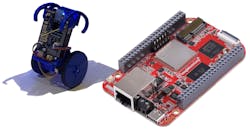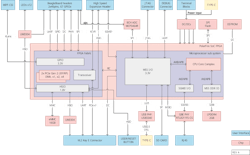BeagleV-Fire Board Blends RISC-V and FPGA
Check out Electronic Design's coverage of CES 2024. This video is also part of the TechXchange: RISC-V: The Instruction-Set Alternative.
What you’ll learn:
- What RISC-V capabilities are provided by the BeagleV-Fire?
- What’s inside a PolarFire SoC FPGA?
I was able to talk with Jason Kridner, founder of BeagleBoard.org, about the organization's latest BeagleV-Fire platform (Fig. 1). The video (above) shows the board controlling a balancing robot.
The BeagleBoard family of modules is built around a dual 46-pin BeagleBone cape header. The BeagleV-Fire is the latest platform. In the demo, a BeagleBone cape with interfaces is used for motor control to handle the wheel motors. The balancing act is trivial with minimal load on the FPGA or RISC-V cores, but it’s visual. The possibilities with an FPGA SoC are very interesting, though.
BeagleV-Fire is built around a Microchip PolarFire MPFS025T FPGA SoC (Fig. 2). This includes a five-core RISC-V system—a 64-bit, SiFive E51 RV64IMAC control processor and four 64-bit, RV64GC SiFive U54-MC cores. The latter includes virtual memory support capable of running operating systems like Linux.
The FPGA incorporates 23K logic elements, 68 math blocks (18 × 18 MACC), and four 12.7-Gb/s SERDES. A SYZYGY connector on the board is targeted at high-speed FPGA connections. The SoC also has 128 kB of eNVM and 65 kB of sNVM.
The module includes 2 GB of LPDDR4 memory, too. Non-volatile storage comes in a 16-GB eMMC chip and 128-Mb SPI flash (Fig. 3). Furthermore, there’s a microSD socket and an M.2 E-Key socket, although that tends to be used for a wireless adapter such as Wi-Fi/Bluetooth. It supports PCIe and SDIO interfaces. Also in the mix is a single, 22-pin CSI camera connector. Gigabit Ethernet is built-in and the USB Type-C operates at 480 Mb/s. And there’s a 6-pin, 3.3-V UART connection plus JTAG support.
In case you want to work with RISC-V but don’t care to have an FPGA on-chip, then the BeagleV-Ahead might be a better bet (Fig. 4). This board is built around an Alibab T-Head TH1520 SoC with a 2-GHz, quad-core, 64GX Xuantie C910 processor with a 4 TOPS@INT8 network processing unit (NPU). It also offers a 50-GFLOPS, 3-Mpixel/s Imagination GXM-4-64 GPU.
This board includes 4 GB of LPDDR4 as well as a 16-GB eMMC flash memory. Memory expansion is via a microSD socket. The system supports Ethernet, dual-band Wi-Fi, and Bluetooth. Other features are a micro-HDMI output, a mikroBUS connection, two CSI camera interfaces, and a DSI connector.
The BeagleBoard family is a popular alternative to Arduino and Raspberry Pi. Microchip’s Libero SoC Design Suite provides FPGA programming support. The RISC-V processors can run BeagleBoard Linux, which comes preinstalled.
Unboxing of the BeagleV-Fire board.
Check out more of Electronic Design's coverage of CES 2024. Also check out more videos/articles in the TechXchange: RISC-V: The Instruction-Set Alternative.
About the Author
William G. Wong
Senior Content Director - Electronic Design and Microwaves & RF
I am Editor of Electronic Design focusing on embedded, software, and systems. As Senior Content Director, I also manage Microwaves & RF and I work with a great team of editors to provide engineers, programmers, developers and technical managers with interesting and useful articles and videos on a regular basis. Check out our free newsletters to see the latest content.
You can send press releases for new products for possible coverage on the website. I am also interested in receiving contributed articles for publishing on our website. Use our template and send to me along with a signed release form.
Check out my blog, AltEmbedded on Electronic Design, as well as his latest articles on this site that are listed below.
You can visit my social media via these links:
- AltEmbedded on Electronic Design
- Bill Wong on Facebook
- @AltEmbedded on Twitter
- Bill Wong on LinkedIn
I earned a Bachelor of Electrical Engineering at the Georgia Institute of Technology and a Masters in Computer Science from Rutgers University. I still do a bit of programming using everything from C and C++ to Rust and Ada/SPARK. I do a bit of PHP programming for Drupal websites. I have posted a few Drupal modules.
I still get a hand on software and electronic hardware. Some of this can be found on our Kit Close-Up video series. You can also see me on many of our TechXchange Talk videos. I am interested in a range of projects from robotics to artificial intelligence.




